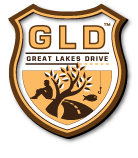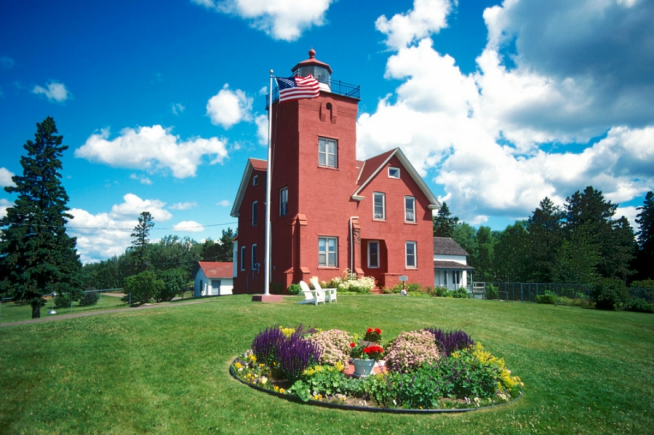Light House Bed & Breakfast Lake County Historical Society
Light House Bed & Breakfast
LightHouse Point, Two Harbors, MN 55616
The Two Harbors Light Station is the oldest operating lighthouse in the US state of Minnesota. Overlooking Lake Superior’s Agate Bay, the Light Station is located in Two Harbors, Minnesota. The construction of the Light Station began in 1891 and completed in 1892. The first lighting of the Two Harbors light was on April 14, 1892.The first Two Harbors Keeper was Charles Lederle and there were normally three Keepers assigned to make sure the light was lit 24 hours a day. The Light Station was built at the request of the Vessel Owners Association and the U.S. Light House Service to provide safe passage into the Agate Bay Harbor. By the 1890’s Two Harbors was the major shipping point for the iron ore of the Vermillion and later the Missabe Range.
Accommodations
Four rooms available, each with a view of Lake Superior that changes continuously. Accommodations offer the lakeshore grandeur and immediate access to the North Shore scenery from the comfort of a B&B that is “home” during your stay. Even our clean and simple common bathroom offers a wonderful lake view. A more rustic room, known as the Skiff House, is located a few steps from the Keeper’s Quarters. Away from the main house it offers a unique sense of privacy.
Historic Information
The 49.6 foot tower is made of red brick and the head keeper’s residence is attached. It towers 78 feet above the surface of Lake Superior and is 12 feet squared. The walls of the tower were built to be 3 bricks thick and the walls where the tower and house meet are a full 5 bricks thick. This was for the safety of the Keeper’s family. The Two Harbors Light Station has a total of six structures; the Lighthouse Tower with the attached Keeper’s Quarters, the Assistant Keeper’s House, the Fog Horn Signal Building, the Oil House, the Skiffhouse and a garage. In addition to the original buildings the historical society has added the Frontenac Pilot House as museum space to the grounds.
The Light Station was originally equipped with a fourth order Fresnel lens, consisting of a series of mirrored prisms that rotated around a fixed flame supplied by oil. The Light Station also included a Fog Signal as part of the original installation. In 1921 the light is lit for the first time by electricity. This drastically changed the duties of the Keepers and the personnel requirements for the Light Station. The Two Harbors Light Station continued to be operated by the U.S. Lighthouse Service until 1939 when the U.S. Lighthouse Service was incorporated into the U.S. Coast Guard. By 1941 technology had advanced allowing for the installation of the Radio Beacon distance finding system. In 1969 the U.S. Coast Guard removed the Fresnel lens and replaced it with a 24” aerobeacon with two 1000-watt bulbs, which are still used today. The beacon is visible an average of 17 miles. The Radio Beacon was short lived as advancements in radar technology quickly replaced it. The Fog Signal fell silent in 1973 and some of the original compressor equipment was shipped to the Smithsonian Institute. The original lens is now on display in the Great Lakes Historical Society Museum in Vermillion Ohio. In 1987 the light was totally automated from the Duluth Coast Guard Station.
The Lake County Historical Society began to provide tours of the Light Station in 1988 when it was granted a lease by the U.S. Coast Guard. In 1999 the Historical Society appealed to Congressman Oberstar and through a bill passed in Congress the ownership of the Two Harbors Light Station was transferred to the Lake County Historical Society. The Lighthouse Bed & Breakfast opened in 1999 as the historical society’s effort to help generate funding to maintain the buildings and grounds. The historical society assumed responsibility from the U.S. Coast Guard for the operation of the light in 2001. The twin aerobeacons are maintained by a group of local citizen volunteers that service the beacons on a monthly basis. They are responsible for; cleaning the lenses, reflectors, and windows in the lantern gallery, changing the lamps out, and changing the oil in the rotating mechanism. A great effort was put forth to ensure that the signature signal flash was recreated; .4 second flash,4.6 seconds of darkness, .4 second flash, 14.6 seconds of darkness. This 20 second pattern is repeated 3 times a minute, all day, every day.
Three of the Light Station’s buildings are open for visitors to tour; The Light Tower which has been restored and fitted with exhibits, houses the rotating light; the Assistant Keeper’s building which has been restored to the late 1800s era and has exhibits on Lake Superior shipwrecks and a kiosk with historical information on the area; and the Frontenac Pilot House featuring an exhibit chronicling the industrial development of Agate Bay.
Currently the Two Harbors Light Station is still designated as an active aid to navigation and is on navigational charts, as well as being a museum. The Two Harbors Light Station is listed on the National Register of Historic Places. For more on the history of the Two Harbors Light Station and its keepers we suggest The Light on Agate Bay by Dale R. Congdon. Available from the Lake County Historical Society.
Phone Number (1-888) 832-5606
All content the property of Lighthouse B & B and Lake County Historical Society.


